

Digital Interventions to Reduce Sedentary Behaviors of Office Workers: Scoping Review. Introduction Background Sedentary behaviors (SBs) are activities that require very low energy expenditure of less than 1.5 metabolic equivalents and typically involve lying down and sitting [].
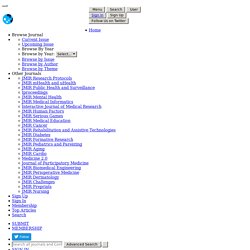
Excessive SB is recognized as an exposure to a risk factor different from a lack of moderate to vigorous physical activity (MVPA), as an individual who engages in 150 min of exercise every week can still spend the majority of the remaining waking hours in SB. Reducing SB may require approaches very different from those required to increase physical activity (PA), as sedentary time can accumulate unintentionally in a broad range of contexts such as during leisure time, transportation, and in the workplace.
Although a recent meta-analysis []indicates that 60 to 75 min of MVPA per day seems to offset the increased risks of mortality associated with sitting for more than 8 hours per day, this amount of MVPA is notably beyond the recommended levels of MVPA in most public health guidelines [,]. Methods. Preventing disease through a healthier and safer workplace. Featured Review: Workplace interventions for reducing time spent sitting at work. Health effects of sit-stand desks and interventions aimed to reduce sitting at work are still unproven.
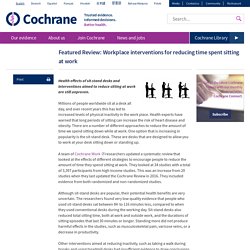
Millions of people worldwide sit at a desk all day, and over recent years this has led to increased levels of physical inactivity in the work place. Health experts have warned that long periods of sitting can increase the risk of heart disease and obesity. There are a number of different approaches to reduce the amount of time we spend sitting down while at work. One option that is increasing in popularity is the sit-stand desk. These are desks that are designed to allow you to work at your desk sitting down or standing up. Corporate Wellness Programs: A New Frontier for RDNs - American Society for Nutrition. Registered dietitian nutritionists (RDNs) are best known for their roles in clinical nutrition, food service management, community nutrition, and public policy.
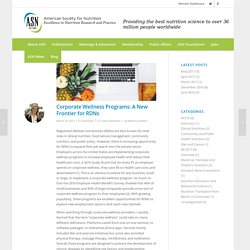
However, there is increasing opportunity for RDNs to expand their job search into the private sector. Employers across the United States are implementing corporate wellness programs to increase employee health and reduce their healthcare costs. A 2010 study found that for every $1 an employer spends on corporate wellness, they save $4 on health care costs and absenteeism (1). Workplace Wellness Recognition for Optimizing Workplace Health.
Worksite Wellness - Today's Dietitian Magazine. June 2015 Issue Worksite Wellness By Juliann Schaeffer Today's Dietitian Vol. 17 No. 6 P. 28 It's a multibillion-dollar business, and career opportunities for dietitians are exploding.
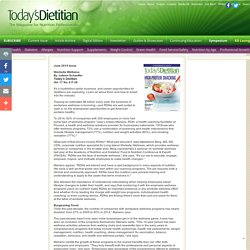
Learn all about them and how to break into the industry. Topping an estimated $6 billion every year, the business of workplace wellness is booming—and RDNs are well suited to cash in on the widespread opportunities to get American workers healthy. "In 2014, 92% of companies with 200 employees or more had some type of wellness program," says Lindsey Mariano, RDN, a health coaching facilitator at Provant, a health and wellness solutions provider for businesses nationwide. What part of that should involve RDNs? Mariano agrees: "RDNs are trained and have a vast background in many aspects of nutrition. Burgeoning Trend "Over the past decade, the number of companies with workplace wellness programs has nearly doubled, from 27% in 2005 to 50% in 2014," Mariano says.
Berg's best tips? Workplace wellness program. Why Workplaces?

Workplaces reach parents and caregivers where they spend the majority of their day, in an environment that can highly influence and support their behaviors around healthy eating and physical activity. These parents and caregivers play an important part in supporting and role modeling 5-2-1-0 behaviors for their children. Center for Science in the Public Interest. Nearly half of our waking hours are spent at work, and many of those hours are spent in meetings and conferences.
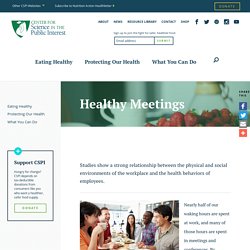
By adopting healthy meeting guidelines, your organization can help to create an environment that supports employees’ and members’ efforts to eat well and be physically active. Below is the Healthy Meeting Toolkit, developed by members of the National Alliance for Nutrition and Activity (NANA). It includes guidance on key components of a healthy meeting and resources to help make hosting healthy meetings easier. Healthy Meeting Resources Healthy Meeting Pledge The undersigned organizations, institutions, and companies have pledged to adopt healthy meeting practices. Action for Healthy Kids Alii Healthcare Alliance for a Healthier Generation American Association of Naturopathic Physicians American Bone Health American Cancer Society Cancer Action Network American Diabetes Association American Public Health Association Annie Appleseed Project. Workplace health: management practices.
This guideline covers how to improve the health and wellbeing of employees, with a focus on organisational culture and the role of line managers.
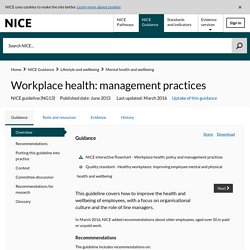
In March 2016, NICE added recommendations about older employees, aged over 50 in paid or unpaid work. Your responsibility The recommendations in this guideline represent the view of NICE, arrived at after careful consideration of the evidence available. When exercising their judgement, professionals are expected to take this guideline fully into account, alongside the individual needs, preferences and values of their patients or service users. The application of the recommendations in this guideline is not mandatory and the guideline does not override the responsibility of healthcare professionals to make decisions appropriate to the circumstances of the individual patient, in consultation with the patient and/or their carer or guardian.
כיבוד 10 - הצעות לכיבוד בריא לישיבות, השתלמויות וקורסים. אפשריבריא - התכנית הלאומית לחיים פעילים ובריאים.